Defining bloater spawning habitat to inform potential impediments to Lake Ontario bloater reintroduction
Contributing Authors
Alex Gatch (USGS, agatch@usgs.gov), Brian Weidel (USGS), John Janssen (UWM), Dale Hansen (USFWS), Nicholas Sard (SUNY-Oswego), Zach Melnick (Inspired Planet), Yvonne Drebert (Inspired Planet), Andrew Muir (GLFC), James McKenna (USGS)
Project Description
Efforts to reintroduce bloater (Coregonus hoyi) in Lake Ontario have been ongoing for 11 years (Weidel et al. 2022). Although more than 1.1 million bloater have been released, the objective of a self-sustaining population has yet to be achieved. Reintroduction efforts have seen some success and bottom trawl recaptures of hatchery-origin bloater have been consistent for the past 8-years, albeit at low abundances (Weidel et al. 2022). Given the number of bloater released and recaptured during annual bottom trawl surveys, the total hatchery-origin bloater population in Lake Ontario was estimated to be between 11 and 45 thousand in 2019 (Weidel et al. 2022). Additionally, one female bloater captured in a bottom trawl, contained developed gametes, suggesting that hatchery-reared bloater can survive to reach reproductive maturity in Lake Ontario (Brian Weidel, pers. comm). However, no evidence of natural reproduction has been detected (e.g., no bloater larvae collected in offshore larval fish collections 2018 CSMI efforts; Brown et al. 2022). If reproductively mature bloater are present in Lake Ontario, it is unknown where these fish may spawn because neither historic nor contemporary spawning grounds have been identified in Lake Ontario (Stone, 1947). Similarly, because little is known about bloater spawning behavior or habitat requirements, it is unclear if spawning habitat is limiting in contemporary Lake Ontario and if sparse or low quality spawning habitat could be an impediment to bloater restoration.
To successfully reintroduce a self-sustaining population of bloater in Lake Ontario, environmental conditions must be suitable for bloater reproduction, otherwise, stocking efforts may be ineffective. But what are suitable environmental conditions for successful bloater reproduction? Looking across their distribution, spawning habitats are narrowly identified for bloater. Koelz (1929) described a protracted spawn from January to March in deep water (>55m) and noted that the type of substrate selected by bloater is unknown. Efforts to identify bloater spawning habitat have not been conducted and have only been inferred through commercial catches of mature adults, collections of larval bloater, and through diet analysis of egg predators (Dryer and Beil, 1968; Eshenroder et al., 2016; Goodyear et al. 1982; Mychek-Londer et al. 2013; Rice et al. 1987; Wells, 1966). Because bloater spawn offshore at a time of year that is difficult to sample (i.e., February), there are limitations to our ability to sample bloater with research vessels, creating a reliance on commercial fishers who have traditionally targeted bloater at this time of year.
Federal agencies have collaborated with commercial fishers for nearly 20 years in Lake Michigan to collect adult bloater during the spawning period. The institutional knowledge held by commercial fishers has contributed to a successful gamete collection program for bloater reintroduction in Lake Ontario (Holey et al. 2021; Weidel et al. 2022) and has helped researchers gain access to spawning adults to address hypotheses related to reproductive ecology in Lake Michigan (Bunnell et al. 2012, 2009). Locating spawning bloater and identifying habitats used for successful egg deposition and incubation may be more efficient with the aid of commercial fishers’ expert knowledge. We recently interviewed one commercial fisher, Dan Anderson, with decades of experience fishing bloater on Lake Michigan. In our interview, Dan described putative bloater spawning habitat as steep drop-offs associated with offshore reefs with rocky or hard bottom. Spawning habitat characteristics described by Dan were based on the presence of mature adults and not gamete deposition, but his descriptions of substrates are consistent with the conceptual models of spawning substates for other native coregonines such as lake whitefish (C. clupeaformis) and cisco (C. artedi) in Lake Ontario (Paufve et al. 2022, Pritchard, 1931; Weidel et al. 2023).
To identify bloater spawning habitat and bottom substrates used for egg incubation, we are proposing to travel to offshore reefs in Lake Michigan in February, observe bloater spawning aggregations, and collect deposited eggs over spawning habitats. Because Lake Michigan bloater are the source for all stocked bloater in Lake Ontario, we assume that behaviors and habitat selection by bloater in Lake Ontario should be similar to those in Lake Michigan. Results will help inform researchers in Lake Ontario who are identifying impediments to bloater reintroduction. Scientists in Lake Ontario will be able to use information gained from our study to locate suspected spawning areas in Lake Ontario, determine if bloater are spawning, and quantify egg deposition and/or survival to evaluate whether habitat is an impediment to bloater reintroduction goals.
